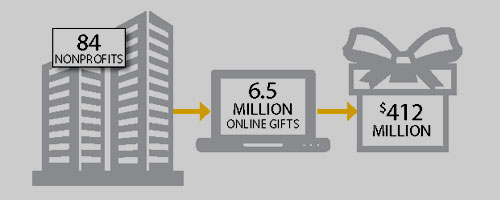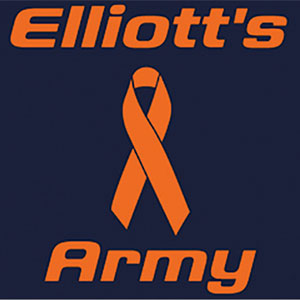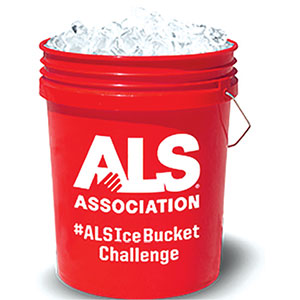Strategy June 22, 2015
Nonprofits Bring Profits
Accounting for 7.3% of ad specialty revenues, nonprofits are the fifth top market adding to industry gains.
Accounting for 7.3% of ad specialty revenues, nonprofits are the fifth top market adding to industry gains.
Among the numerous markets that ad specialty distributors work with, nonprofits rank number five. The market represents 7.3% of industry revenues, according to ASI’s research.
The National Center for Charitable Statistics reports that more than 1.5 million nonprofit organizations are registered in this country. They are public charities, private foundations and other types, including chambers of commerce, fraternal organizations and civic leagues.
As with any organization, the secret to a long-term, successful working relationship with a nonprofit group is communication and networking, longtime professionals working with nonprofits say. Here, experienced ad specialty pros share their tips for creating promotional apparel, accessories and services for nonprofits large and small.
“You can’t always give severe discounts. You have to find that happy medium that will allow you to grow.”
Tom rector, rector communications
Have a Genuine Interest
Making a nonprofit organization a client means being an ancillary part of their goals. Nina Bloomstein Shatz, an account executive at HALO Branded Solutions (asi/218450), benefits from a dual perspective, first working 10 years for a nonprofit organization and later joining the promotional world, where she has worked with nonprofits for the past eight years.
Perhaps the most important tip to remember before approaching a nonprofit is to do your homework. That means dipping into all the public record information you can find, including fundraising budgets and other records. Google can be a big help.
“If you’re fishing for an opportunity, get on a computer, go to the library,”Shatz says. “You can learn a lot by going online. Get to know them and educate yourself on the mission. What is this organization trying to do, and why do they need promotional items? What events are they hosting? What is unique to them? What’s coming up (such as a 25th annual event)?”
One big difference between an average business and a nonprofit is the presence of “lay people”who are not necessarily employed by the organization but have paired up with an employee to work on a fundraiser. As someone trying to get the nonprofit’s business, sometimes the best way to get a foot in the door is to actually volunteer for an event and make connections with these community people. Find out how they work. What kind of budget were they using for a previous fundraiser?
By knowing what the organization is all about and how it works, Shatz is able to approach individuals using a more personal touch. “I can’t stress enough the importance of being educated on what these groups do,”she says. “If you walk in and don’t know what their goals are, you come off as unprofessional. You’re creating a relationship with them. They’ll call you for other things in the future.”
Don’t Assume
Working with a nonprofit business is akin to working with any business, from tiny budget startups that benefit from pro bono work, to huge organizations with high-end, well-paying clients and large marketing budgets. When it comes to a good cause, MODassic Marketing (asi/269963) owner Ryan Short tries to impress upon clients that paying for promotional marketing services is not an expense but an investment.
“Don’t assume that your offer must be cheap,”he says. “Don’t be shy about marketing solutions that are going to make more for the nonprofit. Knowing that takes learning.”He has been working with nonprofits for the past five years.
CEO Tom Rector of distributor firm Rector Communications (asi/305623) says the company’s philosophy is to better the community by staying in business. “We want to keep helping people, and so we want to stay in business. To do that, you can’t make poor business decisions just to save money in the short term. You can’t always give severe discounts. You have to find that happy medium that will allow you to grow,”he says.
One approach Short’s company uses involves bringing its various clients together in support of a cause. For-profit companies can help nonprofit ones. For example, SanMar (asi/84863) has agreed to partner with MOD-assic Marketing and a nonprofit organization to donate backpacks for children. “Working together makes our clients appreciate each other and us as well. The goodwill goes around,”Short says.
Rector Communications even launched a philanthropic branch called Ink The Cause in 2014 (www.inkthecause.com). It involves a Web-based system where anyone wanting to raise money for a cause can design a product and sell it online through various networks raising money for any type of cause. Better yet, 100% of the proceeds goes back to the causes.
The website gives nonprofit groups a simple and low-risk way to generate revenue by selling merchandise online. Using the site makes sense for smaller nonprofits who don’t want to spend a lot of time and money setting up their own online stores. It’s also a source of publicity for those nonprofits, who mention it in newsletters and on social media.
Come to the Rescue
Relentless networking and relationship building is the key to a lot of what the promotional world does. “When you create relationships with your clients, you’re showing them that they are important to you. That should be stressed in our business, because it is what leads to confidence and trust and being referred to other people,” Shatz says.
In a promotional success story Shatz calls “extremely quirky,”she began working with the AIDS Support Group of Cape Cod in Provincetown. When an opportunity arose to spread the message about free HIV testing during the busy summer beach season, she reached out to the support group and the Massachusetts Department of Public Health, which donates 100,000 condoms twice a year to the group.
Together, they created labels to put on the outside of the condom wrapper that say, “This is just between you and me,”along with advice about getting free HIV testing and a website URL for more information.
“The most interesting part is that they partnered with the local senior center,”Shatz says. “So you have a room full of senior citizens putting condom labels on wrappers. This was truly a community effort.”
Shatz has also produced T-shirts for the group as giveaways. Her efforts to reach out to the group are paying off in the long run. “I started with one gentleman in the organization, and while he has risen through the ranks, people in his position always pass my name to the next person. I know they’ll come back to me again and again,”she says.
Good Timing
Another distinction to keep in mind about nonprofit groups is that their calendar years are usually different than regular business fiscal years. So plan in advance. Tell the nonprofit that you know they will be closing their books soon, and that you would like to talk about plans for the next year.
“Towards the end of their calendar year, a lot of organizations have some money to burn,”Shatz says. “You could say, ‘can I give you a quote on what I can do for some of your events?’”
Nonprofits may fundraise more energetically during certain months, with events such as walks. October is Breast Cancer Awareness month, for example. In the promotional world, take into account when people are looking to buy products for these events.
Weave the Web

An online presence is a valuable tool for nonprofits. A 2015 study from M+R Benchmarks (http://mrbenchmarks.com) found that 84 participating nonprofits raised almost 6.5 million gifts online, totaling more than $412 million. The study also found that the percentage of gifts raised by first-time online donors increased 20% from the previous year.
Always look for new ideas to present as well. Shatz does this by keeping clients in mind even when she’s not working on their projects. Trade shows, for instance, are an ideal place to find new ideas and vendor products. She gets samples and keeps up to date on trends and unusual items. In this regard, good vendor relationships are equally important.
Rector Communications keeps client interest alive in various ways, including sweetening its merchandise deals by providing profit-share programs and adding some services for free. For the National Association for Home-care and Hospice convention of 8,000 people, Rector provided all the custom convention bags, lanyards, name badges, key cards with sponsors’ names on them, and staff shirts. Rector then built an online merchandise store with clothing and accessory designs printed with their logo.
“We have to think about our client’s ultimate marketing strategy goal.”
Ryan short, modassic
“We generated really good sales with the online store,”Rector says. “People who registered for the convention online were kicked over to their store website, selling items like shirts with ‘I Love Nursing’ on them.”Once Rector had the data to show success with convention sales, his company had the credibility and funds to set up a physical store at a future convention.
“We were able to give the nonprofit 20% of their total merchandise revenue,”he says. “In addition, on the first day of the convention, they were able to give back $2,000 of additional earnings.”The unexpected bump in donations from Rector Communications cemented its relationship with the nonprofit.
“We still do that today with nonprofits. It just makes sense,” he says.
Great Ideas

Consider adding hats to your promotional repertoire. While the custom wristband and the T-shirt have been the go-to choice of charities, many are starting to consider hats in their line of attention-getting products. One such group in Perth, WA, is using hats because they are more visible than wristbands and large enough to handle most logos and text, according to PRWire (http://prwire.com.au/pr/51687/promotional-headwear-helps-charities-publicise-their-causes). Elliot’s Army, started in 2009 to support children’s cancer research, gives hats to fundraiser participants. The hats are cool accessories when participating in outdoor activities and they attract attention, according to their promoter, ImagePak Marketing.

Get creative finding products and services that piggyback on great crowdfunding and peer-to-peer campaigns, which rely heavily on social media. Witness the ALS Ice Bucket Challenge, which went viral online. Since July 29, 2014, The ALS Association has received more than $220 million in donations from around the world (www.alsa.org/fight-als/ice-bucket-challenge.html). Likewise, the World Wildlife Fund last spring started Panda Nation (wwf.worldwildlife.org/site/PageServer?pagename=panda_nation_fundraising), which helps supporters turn everyday events such as birthdays and athletic competitions into fundraising events, according to The Chronicle of Philanthropy (https://philanthropy.com/article/6-Trends-to-Watch-in-2015/151995).

Think outside the box to offer products and services that will grow the nonprofit organization’s scope and size. Nonprofits that will be successful in the future are going beyond just raising dollars toward their missions – they want to expand. Nonprofits are more open than ever to finding new and creative ways to generate revenue, including selling products related to the mission, according to FundRaising Success Magazine (www.fundraisingsuccessmag.com/article/70-nonprofit-trends-2015/1).
Offer Custom Solutions
Nonprofits try to prove to their members that they are getting the most for their donations. For Rector, that challenge spurs creativity. “I believe nonprofits make the best customers. They’re awesome to work with, because they’re in it for the greater good,”he says. “When we do shirts for a mission trip, we know it’s making an actual impact.”
Ink the Cause has experienced repeated successes connecting with many nonprofit groups, including large organizations such as the National Association for Homecare & Hospice and the American Teachers Association. Rector says his company benefits from the website service because it gets access to more nonprofits, many of whom ask him to create custom products for them. The company can make custom products on demand and save money by not carrying a glut of pre-made inventory.
Rector turns around and gives part of the company’s sales profits to its nonprofit clients. Over the past eight months, it has contributed $42,000 to charitable efforts. “We are growing so well that we can invest a lot of money back into the system, which is allowing us to scale our business up much faster so we can run multiple campaigns simultaneously,”he says.
“How we get our foot in the door is all in the strength of our networks and the referrals from groups we’ve worked with in the past,”says Rector. “If you have a target group you want to work for, find a mutual connection through an existing customer or vendor.”
Part of MODASSIC’s services also includes Web design, which can go a long way toward attracting public attention and new donors. “We have to think about our client’s ultimate marketing strategy goal,”Short says. “What are you hoping these T-shirts achieve? You’ll learn that you should maybe go with a shirt designed to achieve a specific goal. If more people wear it, you’ll get more recognition and more donations.”
Nonprofits offer a great deal of opportunity and come in many varieties. “From humane societies to church camps to autism daycares, they all can use our services, and we can help them do the good work they’re doing,” Rector says. “So be creative in how you put deals together and find ways that make sense for your business and help a good cause at the same time.”
Manasee Wagh is a PA-based freelance writer.
